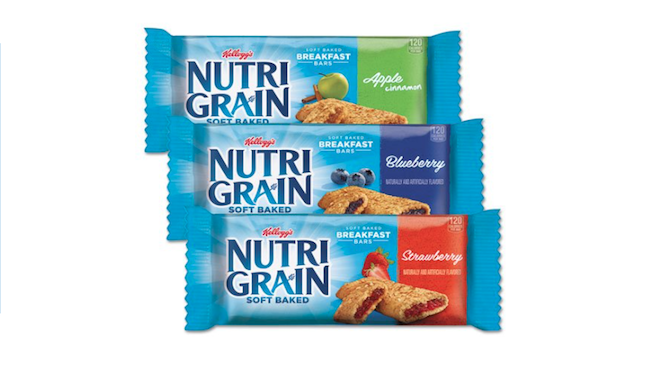Are Nutri-Grain Bars Actually Healthy?
Americans want their food healthy, convenient and delicious.
The demand for those three criteria has driven the explosive growth of breakfast, cereal and snack bars. A product sector which hardly existed a couple decades ago, such “healthy” bars now dominate entire aisles in many grocery stores.
One of the most popular options? Kellogg’s Nutri-Grain Bars.
According to Statista, Americans bought over 190 million dollars worth of Nutri-Grain Bars in 2017. At a glance, they seem to meet the three coveted criteria of healthy, convenient and delicious. But they wouldn’t be the first bar to cover up for disappointing nutrition with slick marketing. Here’s the full story on this pantry and lunchbox staple.
Are Nutri-Grain Bars Healthy?

Photo via Kellogg’s
The full name for Nutri-Grain Bars are Kellogg’s Nutri-Grain Soft Baked Breakfast Bars. Promoting the “Soft Baked” nature of the product was actually a major turning point in its success, as it emphasizes the healthy, wholesome nature of the product.
Taking a closer look at the packaging for Nutri-Grain bars, it’s usually plastered with phrases like “Made with Real Fruit,” “No High Fructose Corn Syrup,” and “Morning Energy with 8G Whole Grains.” Each Nutri-Grain variety is generally associated with some type of fruit, and the use of whole grains in the recipe is heavily emphasized.
Together, these factors are enough to convince a huge swath of consumers the product is healthy. But what do the nutrition facts and ingredients say?
The nutrition facts for one Kellogg’s Nutri-Grain Soft Baked Strawberry Breakfast Bar are as follows:
- 130 calories
- 3.5 grams total fat
- .5 grams saturated fat
- 140mg sodium
- 25 grams total carbohydrate
- 1 gram fiber
- 12 grams sugar
- 2 grams protein
The bar also includes 10% the recommended daily value of calcium, iron, vitamin A, thiamin, riboflavin, niacin, vitamin B6 and zinc. Other Nutri-Grain varieties have very similar nutrition facts.
The biggest red flag is the sugar content.
Nutri-Grain bars generally contain 11 or 12 grams of sugar per bar.
A lot of people would write the sugar off as being “from the fruit,” meaning it’s not as innutritious. While this is true for whole fruit, there’s really not much fruit in Nutri-Grain bars, and what is there is so nutritionally degraded during processing that it’s hard to consider it “fruit.” For example, the only ingredient you’ll find in a Strawberry Nutri-Grain bar that actually utilizes that particular fruit is Strawberry Puree Concentrate. This form lacks the fruit’s natural fiber and vitamin C content, which were destroyed during processing. While it’s more shelf-stable than real fruit, it’s really just another way to add sugar to a product.
In addition to fruit puree concentrates, Nutri-Grain bars are also stuffed with sweeteners like sugar, dextrose, fructose, invert sugar and corn syrup. All or nearly all the sugar in Nutri-Grain bars qualifies as “added sugar.”
Added sugars (defined as “sugars or caloric sweeteners added to foods or beverages during processing or preparation”) are perhaps the most harmful ingredient in the modern American diet, largely because we eat them in absurd quantities. The American Heart Association recommends women consume no more than 25 grams of added sugar per day while men should consume no more than 36 grams a day. Again, many Nutri-Grain bar varieties contain 12 grams of added sugar, or nearly half the daily limit for women. That’s not ideal.
The 1-2 grams of fiber in most bars is also somewhat disappointing. If added sugar is the ingredient Americans consume too much of, fiber might be the one thing they need more of (ideally in the form of fresh produce and whole grains). The AHA recommends at least 21-25 grams of fiber a day for women under 50 and 30-38 grams a day for men under 50.
Fiber helps break down foods for easier digestion, maintains good bowel health, lowers cholesterol levels and helps you feel fuller longer. High-fiber diets have been linked to positive outcomes such as a reduced risk of diabetes and heart disease. In the short term, snacking on a bar high in fiber keeps you fuller for longer and helps you avoid crashing. In the long term, it reduces your risk of many major diseases and supports good bowel health.
Though Nutri-Grain bars contain both fruit and whole grains, two food groups often high in fiber, those ingredients aren’t present in large enough amounts—or are too significantly degraded during processing—to make them a high-fiber snack.
Nutri-Grain bars don’t offer much in the way of protein, either. Protein helps build muscle and allows you to recover from exercise, but it can also help keep you full. With only small amounts of fiber and protein in each Nutri-Grain bar, they’re very unlikely to keep you satiated for long.
Nutri-Grain bars are high in added sugar while containing only middling amounts of fiber and protein. Quite honestly, that’s a terrible formula if you’re looking for a healthy, nutritious bar. And we haven’t even gotten into the large quantity of questionable ingredients included in the recipe of many Nutri-Grain bars. Ingredient Inspector has a phenomenal post on that very topic. And don’t believe the new Kids Nutri-Grain bites are much better—they’re essentially the same recipe.
Are Nutri-Grain bars healthier than candy bars? Generally, yes. But that’s not saying much.
If you’re used to grabbing one for breakfast, you’d be better off just eating an actual apple or banana, perhaps alongside some wheat toast. And if you’re used to grabbing one as a snack and love the convenience factor of pre-packaged bars, an RXBAR or Lärabar is likely a superior nutritional option.
Photo Credit: Kellogg’s
READ MORE:
RECOMMENDED FOR YOU
MOST POPULAR
Are Nutri-Grain Bars Actually Healthy?
Americans want their food healthy, convenient and delicious.
The demand for those three criteria has driven the explosive growth of breakfast, cereal and snack bars. A product sector which hardly existed a couple decades ago, such “healthy” bars now dominate entire aisles in many grocery stores.
One of the most popular options? Kellogg’s Nutri-Grain Bars.
According to Statista, Americans bought over 190 million dollars worth of Nutri-Grain Bars in 2017. At a glance, they seem to meet the three coveted criteria of healthy, convenient and delicious. But they wouldn’t be the first bar to cover up for disappointing nutrition with slick marketing. Here’s the full story on this pantry and lunchbox staple.
Are Nutri-Grain Bars Healthy?

Photo via Kellogg’s
The full name for Nutri-Grain Bars are Kellogg’s Nutri-Grain Soft Baked Breakfast Bars. Promoting the “Soft Baked” nature of the product was actually a major turning point in its success, as it emphasizes the healthy, wholesome nature of the product.
Taking a closer look at the packaging for Nutri-Grain bars, it’s usually plastered with phrases like “Made with Real Fruit,” “No High Fructose Corn Syrup,” and “Morning Energy with 8G Whole Grains.” Each Nutri-Grain variety is generally associated with some type of fruit, and the use of whole grains in the recipe is heavily emphasized.
Together, these factors are enough to convince a huge swath of consumers the product is healthy. But what do the nutrition facts and ingredients say?
The nutrition facts for one Kellogg’s Nutri-Grain Soft Baked Strawberry Breakfast Bar are as follows:
- 130 calories
- 3.5 grams total fat
- .5 grams saturated fat
- 140mg sodium
- 25 grams total carbohydrate
- 1 gram fiber
- 12 grams sugar
- 2 grams protein
The bar also includes 10% the recommended daily value of calcium, iron, vitamin A, thiamin, riboflavin, niacin, vitamin B6 and zinc. Other Nutri-Grain varieties have very similar nutrition facts.
The biggest red flag is the sugar content.
Nutri-Grain bars generally contain 11 or 12 grams of sugar per bar.
A lot of people would write the sugar off as being “from the fruit,” meaning it’s not as innutritious. While this is true for whole fruit, there’s really not much fruit in Nutri-Grain bars, and what is there is so nutritionally degraded during processing that it’s hard to consider it “fruit.” For example, the only ingredient you’ll find in a Strawberry Nutri-Grain bar that actually utilizes that particular fruit is Strawberry Puree Concentrate. This form lacks the fruit’s natural fiber and vitamin C content, which were destroyed during processing. While it’s more shelf-stable than real fruit, it’s really just another way to add sugar to a product.
In addition to fruit puree concentrates, Nutri-Grain bars are also stuffed with sweeteners like sugar, dextrose, fructose, invert sugar and corn syrup. All or nearly all the sugar in Nutri-Grain bars qualifies as “added sugar.”
Added sugars (defined as “sugars or caloric sweeteners added to foods or beverages during processing or preparation”) are perhaps the most harmful ingredient in the modern American diet, largely because we eat them in absurd quantities. The American Heart Association recommends women consume no more than 25 grams of added sugar per day while men should consume no more than 36 grams a day. Again, many Nutri-Grain bar varieties contain 12 grams of added sugar, or nearly half the daily limit for women. That’s not ideal.
The 1-2 grams of fiber in most bars is also somewhat disappointing. If added sugar is the ingredient Americans consume too much of, fiber might be the one thing they need more of (ideally in the form of fresh produce and whole grains). The AHA recommends at least 21-25 grams of fiber a day for women under 50 and 30-38 grams a day for men under 50.
Fiber helps break down foods for easier digestion, maintains good bowel health, lowers cholesterol levels and helps you feel fuller longer. High-fiber diets have been linked to positive outcomes such as a reduced risk of diabetes and heart disease. In the short term, snacking on a bar high in fiber keeps you fuller for longer and helps you avoid crashing. In the long term, it reduces your risk of many major diseases and supports good bowel health.
Though Nutri-Grain bars contain both fruit and whole grains, two food groups often high in fiber, those ingredients aren’t present in large enough amounts—or are too significantly degraded during processing—to make them a high-fiber snack.
Nutri-Grain bars don’t offer much in the way of protein, either. Protein helps build muscle and allows you to recover from exercise, but it can also help keep you full. With only small amounts of fiber and protein in each Nutri-Grain bar, they’re very unlikely to keep you satiated for long.
Nutri-Grain bars are high in added sugar while containing only middling amounts of fiber and protein. Quite honestly, that’s a terrible formula if you’re looking for a healthy, nutritious bar. And we haven’t even gotten into the large quantity of questionable ingredients included in the recipe of many Nutri-Grain bars. Ingredient Inspector has a phenomenal post on that very topic. And don’t believe the new Kids Nutri-Grain bites are much better—they’re essentially the same recipe.
Are Nutri-Grain bars healthier than candy bars? Generally, yes. But that’s not saying much.
If you’re used to grabbing one for breakfast, you’d be better off just eating an actual apple or banana, perhaps alongside some wheat toast. And if you’re used to grabbing one as a snack and love the convenience factor of pre-packaged bars, an RXBAR or Lärabar is likely a superior nutritional option.
Photo Credit: Kellogg’s
READ MORE:










